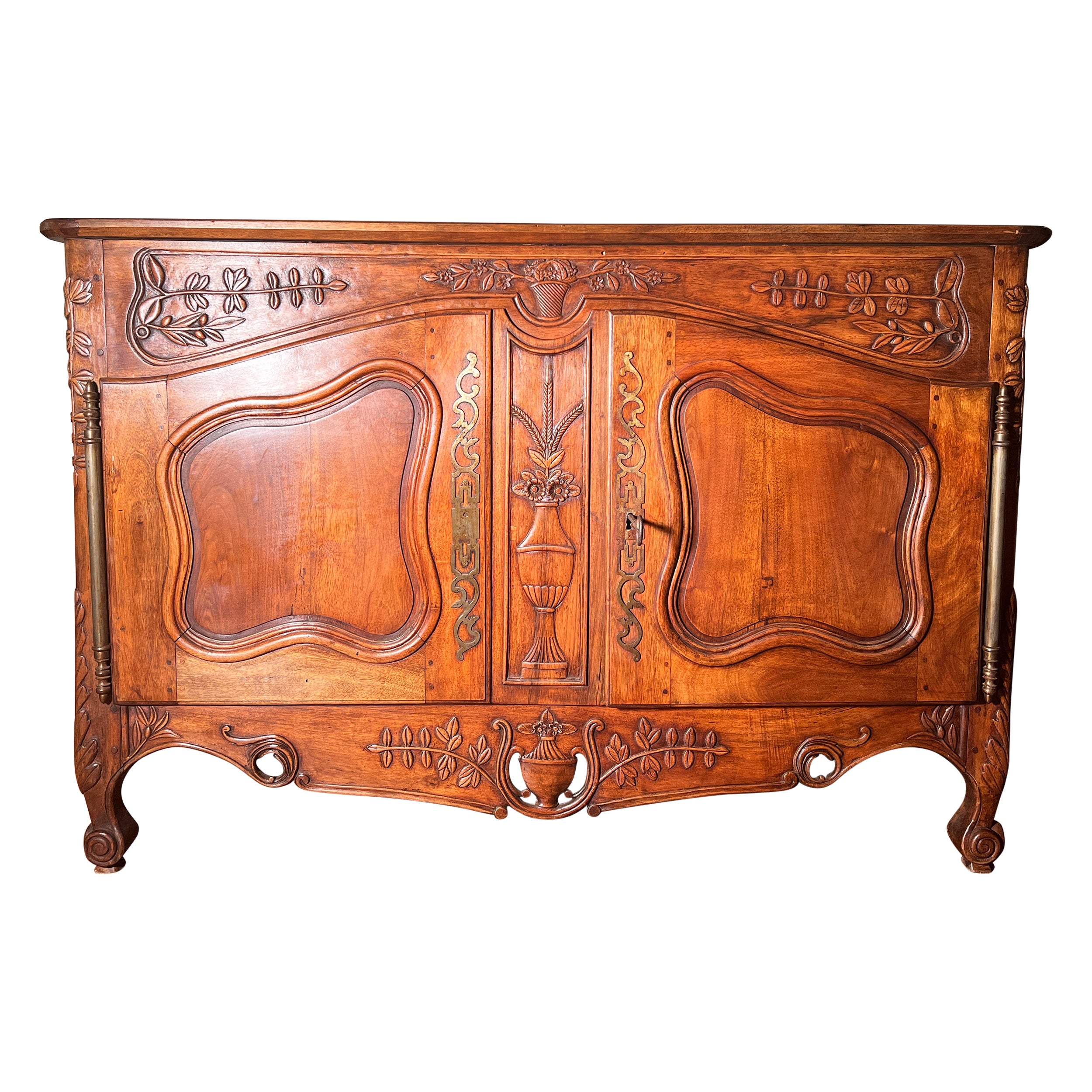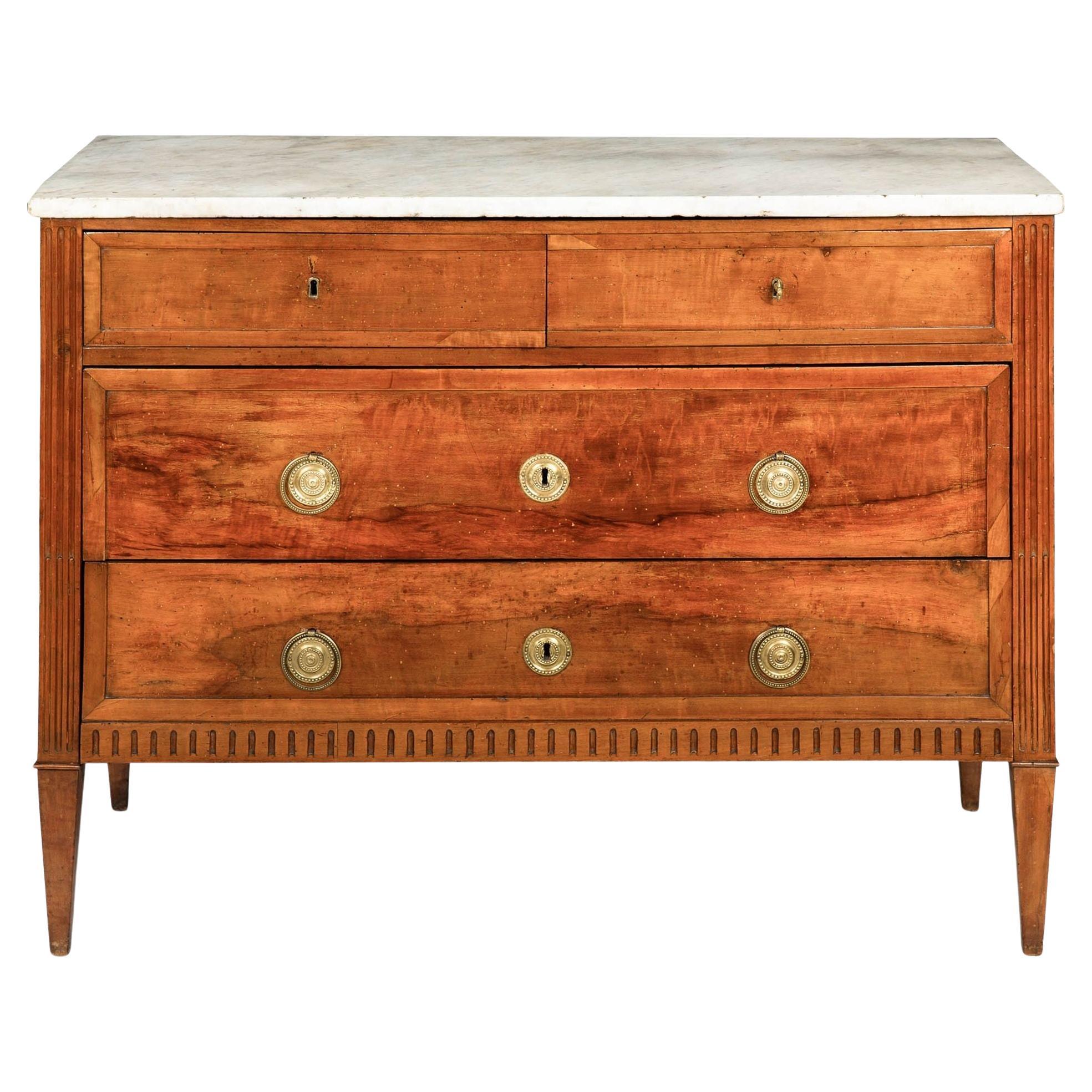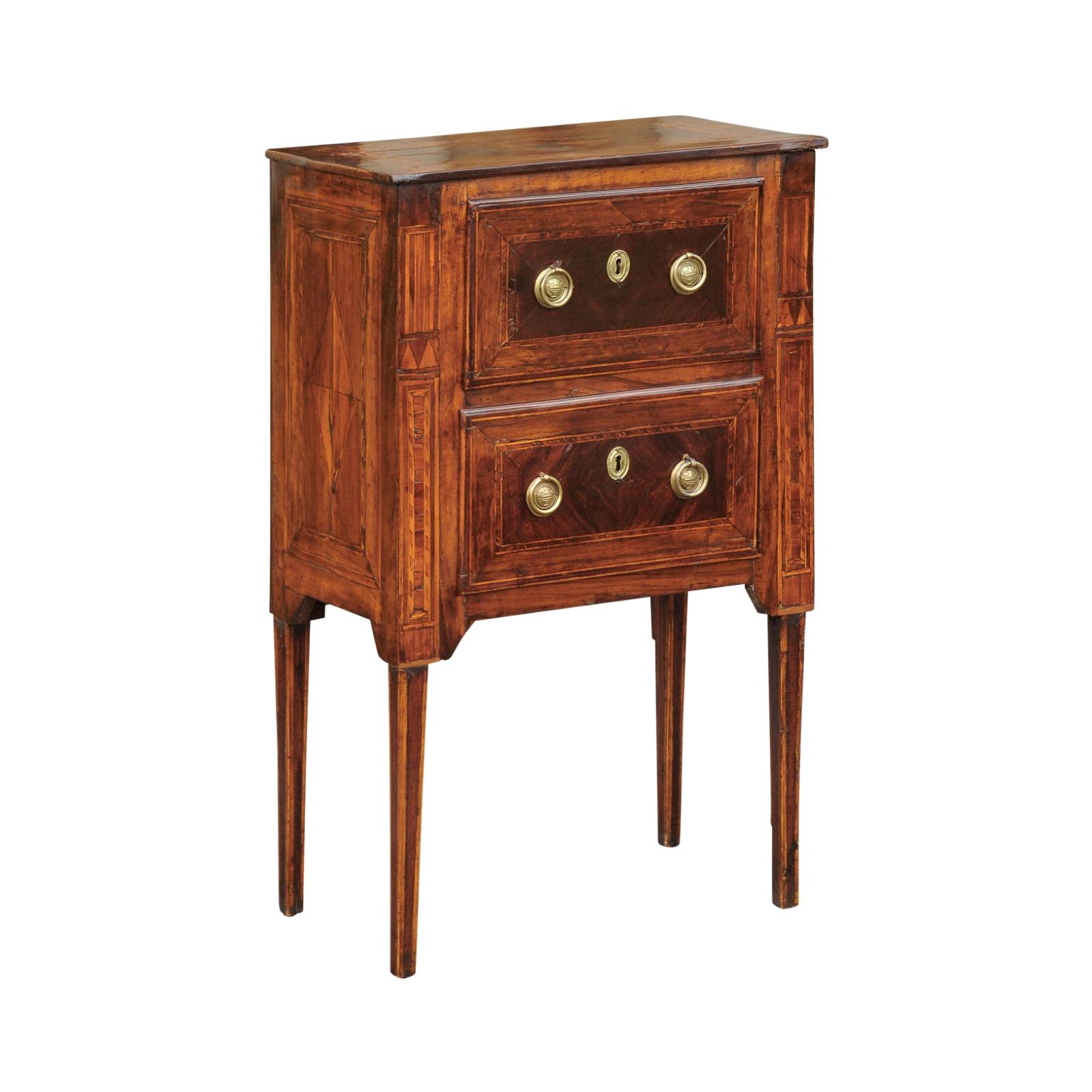Items Similar to Baltic Commode, Circa 1800
Want more images or videos?
Request additional images or videos from the seller
1 of 6
Baltic Commode, Circa 1800
About the Item
This mahogany commode has the fluted rails and canted corners typical of case furniture made along the coasts of the Baltic and North Seas around 1800. More difficult to pinpoint, however, is the exact place of its making, since this geographical region stretches from Germany to Russia, and north from Poland to Scandinavia. That said, a strikingly similar, if slightly plainer commode in a private German collection bears an old paper label that identifies it as having been made in the city of Altona. It also bears the seal of King Christian VII of Denmark who reigned until 1808. At the time, Altona was in the independent Duchy of Schleswig-Holstein, located between Denmark and Prussia. Both nations tried to annex the Duchy, and in 1848 it was ceded to Prussia, which became part of Germany in 1871.
A North Sea port, Altona was a member of the Hanseatic League, an association of seaports that was established in the 14th century to foster trade and police the high seas. Around 1800, the aforementioned King Christian of Denmark, who was also the Duke of Schleswig-Holstein, allowed Jews to freely settle in Altona to increase the tax base. This allowed them to conduct business in neighboring Hamburg, a larger financial hub that maintained quotas. The prosperous Jewish families of Altona built villas there, and decorated them with furnishings that were made locally and imported. Many of those makers owned copies of furniture-pattern books, which were widely disseminated among these seaports, accounting for the difficulty in determining if a piece was made in Altona, Stockholm, or St. Petersburg.
We can’t trace our commode to a Danish king or a known Altona merchant, but we can link it to the New World empire builders David and Vivian Campbell. In 1945, with a $2,000 loan, they opened a record store in Montreal and expanded it to sell household electronics and appliances. They went on to establish a cable television company, and online systems for banking and brokerage houses. As philanthropists, they endowed the Art Gallery of Ontario’s Campbell Centre for Contemporary Art, and were patrons of the Toronto Symphony and the University of Toronto. They also formed an art collection, concentrating on contemporary photography, and modern painting from Edvard Munch to David Hockney. Not bad for the son of a penniless Jewish immigrant who, in 1915, set sail to Halifax from Vilnius in Poland, then under the thumb of the Czar, but an independent Hanseatic port in better days. On arrival, Samuel Kimmel didn’t speak English, and so, being incomprehensible to immigration officials, his papers were processed under the name Samuel Campbell. Decades later, on buying this commode, his son may or may not have known of its Baltic origins, or of the role of Jewish financiers in Altona.
- Dimensions:Height: 34 in (86.36 cm)Width: 37.75 in (95.89 cm)Depth: 20.25 in (51.44 cm)
- Style:Neoclassical (Of the Period)
- Materials and Techniques:
- Place of Origin:
- Period:
- Date of Manufacture:circa 1800
- Condition:Repaired: Replacement of missing drawer edging, and assorted touchups before it was polished. There were earlier repairs to veneers. Overall, in good condition, and no need for further restoration. Replacements made: One key escutchoen replaced with a perfect match. Wear consistent with age and use.
- Seller Location:New York, NY
- Reference Number:1stDibs: LU1061426085542
About the Seller
5.0
Recognized Seller
These prestigious sellers are industry leaders and represent the highest echelon for item quality and design.
Established in 1994
1stDibs seller since 2014
19 sales on 1stDibs
- ShippingRetrieving quote...Ships From: New York, NY
- Return PolicyThis item cannot be returned.
More From This SellerView All
- Unusual Large English Glass Candlestick, circa 1800Located in New York, NYThis large and dramatic blown and cast-glass candlestick, with a blue-and-white spiral in its stem, was most likely made in England around 1800. It comes from the collection of the legendary aesthete Baron Max Fould-Springer, who lived at the Palais de Royaumont outside Paris, which on his death was inherited by his sister Liliane, Baroness de Rothschild...Category
Antique Early 1800s Great Britain (UK) George III Candlesticks
MaterialsGlass
- French Trompe L'oeil Drawing Circa 1800Located in New York, NYThis trompe l'oeil drawing depicts the artist's tools -- a black and a red crayon, and a folding steel ruler that was painted with silver pigments, which have blackened with age. They're shown on a sheaf of papers that include a medieval manuscript page, a musical score, and a group of prints. The unifying theme is the artistic patronage of the Medici, the Grand Dukes of Tuscany, who intermarried with the Habsburgs, who were the Holy Roman Emperors. Among the papers are prints by Stefano Della Bella, the Florentine artist who worked for the Medici. They depict a negro page with a horse, and portraits of Lorenzo Lippi...Category
Antique Early 1800s French Empire Drawings
MaterialsPaper, Paint
- Circa 1930 German Side TableBy Fritz August Breuhaus de Groot 1Located in New York, NYOur table was made of birch, solid and veneered, stained a rich brown, and topped off with a slab of Bohemian breccia marble. We date it to around 1928, and attribute the design to Fritz August Breuhaus de Groot, who coined the term Kultivierte Sachlichkeit (Cultured Objectivity) to describe his work, and distinguish it from the Neue Sachlichkeit (New Objectivity) practiced by his contemporaries Walter Gropius, Mies van der Rohe, and Lily Reich. The table bears a passing resemblance to a considerably simplified, marble-topped ovoid one that he designed for his 1934 Berlin living room. Breuhaus was a man on the make. The first of his three marriages was to the daughter of an industrialist, who financed the building of luxury villas and workers’ housing designed by his son-in-law. In 1929, Breuhaus, the son of a dentist, added “de Groot” to his name, falsely linking himself to a distinguished family of painters. By then, he’d been fudging his academic record for years. That didn’t prevent a teaching appointment at the State University of Bavaria, which allowed him to add the prestigious “Herr Professor” prefix to his name. Yet he never followed through on the teaching — he was far too busy designing more luxury villas (commissions he accepted only if he could furnish them as well), and products for his own company, which included furniture, textiles, wallpapers, lighting, and fine silver. In addition to designing aircraft interiors for Lufthansa, and pullman railroad...Category
Vintage 1920s German Modern Side Tables
MaterialsMarble
- John Bradstreet Bronze Lotus, circa 1900By John Scott BradstreetLocated in New York, NYFrom the 1890s until his death in 1914, John Bradstreet, the important American Arts and Crafts furniture and interior designer, worked from The Crafts House, his landscaped orientalist compound in Downtown Minneapolis. There, he also received his clients, and dealt in Asian art acquired on frequent trips to the Far East. He used similar bronze Japanese lotuses...Category
Antique Early 1900s American Arts and Crafts Garden Ornaments
MaterialsBronze
- American Arts & Crafts Sculpture of a Pelican, Circa 1910Located in New York, NYThe unknown sculptor of this fine, gilded-mahogany pelican appears to have been influenced by the turn-of-the-century Symbolist movement in Europe. The breast feathers are subtly car...Category
Antique Early 1900s American Arts and Crafts Animal Sculptures
MaterialsWood
- Pair of French Rock-Crystal and Gilt-Bronze Candlesticks Circa 1950By Bonzano Paris 1Located in New York, NYThis exquisite pair of candlesticks was retailed by Bonzano, a Paris firm that specialized in ormolu-mounted rock crystal objects. They have an interior channel to permit electrific...Category
Vintage 1950s French Régence Candle Holders
MaterialsRock Crystal, Ormolu
You May Also Like
- Baltic Directoire Style Mahogany and Satinwood Inlaid Commode, circa 1800Located in Kinderhook, NYAn elegant circa 1800 Prussian Baltic Directoire style three drawer commode having luminescent mahogany veneered and satinwood line-inlaid oak and pine case, the thick slab top above locking top drawer with center cornucopia and foliate scroll gilt-metal keyhole escutcheon...Category
Antique Early 1800s Baltic Baltic Commodes and Chests of Drawers
MaterialsMetal
- Northern Italian Walnut Commode , circa 1800Located in Los Angeles, CAThe rectangular inlaid top above five drawers raised on square tapered legsCategory
Antique Early 19th Century Italian Commodes and Chests of Drawers
MaterialsWalnut
- Parquetry Veneered Italian Commode, circa 1800Located in Newport Beach, CAChic, canted corner, three-drawer, walnut and pearwood commode from Modena, Italy. Striking parquetry surrounds the piece three quarters.Category
Antique Early 1800s Italian Commodes and Chests of Drawers
MaterialsPearwood, Walnut
- Antique French Provincial Commode Circa 1800Located in New Orleans, LAAntique French Provincial Commode Circa 1800Category
Antique Early 19th Century French Commodes and Chests of Drawers
MaterialsWalnut
- French Neoclassical Provincial Chest of Drawers Commode circa 1800Located in Shippensburg, PADIRECTOIRE PERIOD PROVINCIAL FRUITWOOD COMMODE France, circa 1800 with Cararra marble top Item # 307JYR13Q A beautifully worn and patinated commode from the first years of the 19t...Category
Antique 19th Century French Neoclassical Commodes and Chests of Drawers
MaterialsMarble, Brass, Iron
- Petite Italian Neoclassical Period Walnut Commode circa 1800 with Inlaid DécorLocated in Atlanta, GAA petite Italian neoclassical period walnut commode from the early 19th century, with inlaid motifs and two drawers. Born in Italy during the early years of the 19th century, this ex...Category
Antique Early 19th Century Italian Neoclassical Commodes and Chests of D...
MaterialsBrass
Recently Viewed
View AllMore Ways To Browse
Antique Television Cabinet
Antique Tv Cabinet
Antique Tv Cabinets Furniture
Danish High Chest
Danish Tv
Neoclassical Mahogany Commodes
Commode With Paintings
Large Tv Cabinet
Built In Corner Cabinet
Coast Storage
Danish Record
Mahogany Canted Corner Chest
Old Tv
Old Television
Large Empire Chest
Sea Chest
Antique Police
Antique Hub





